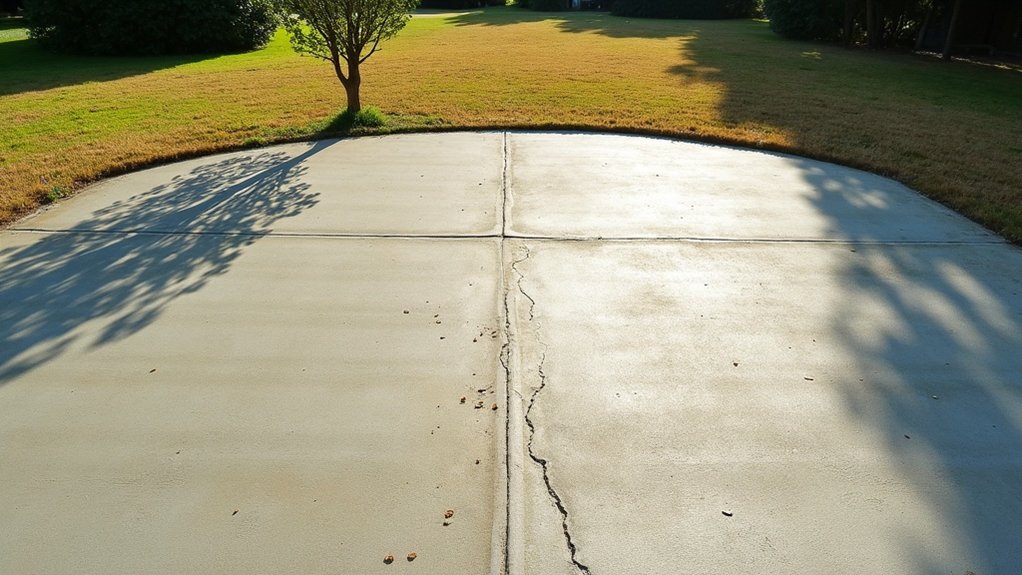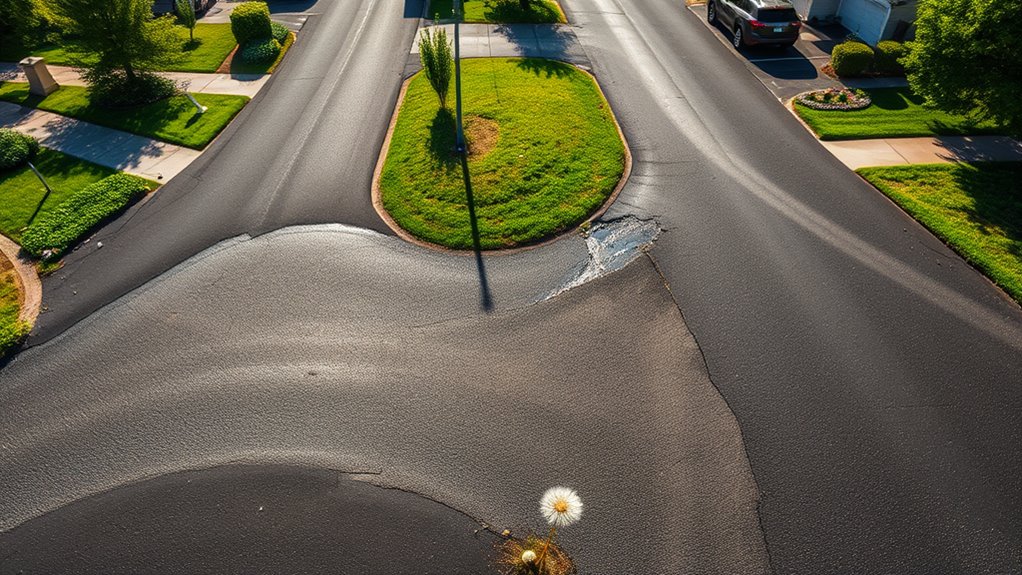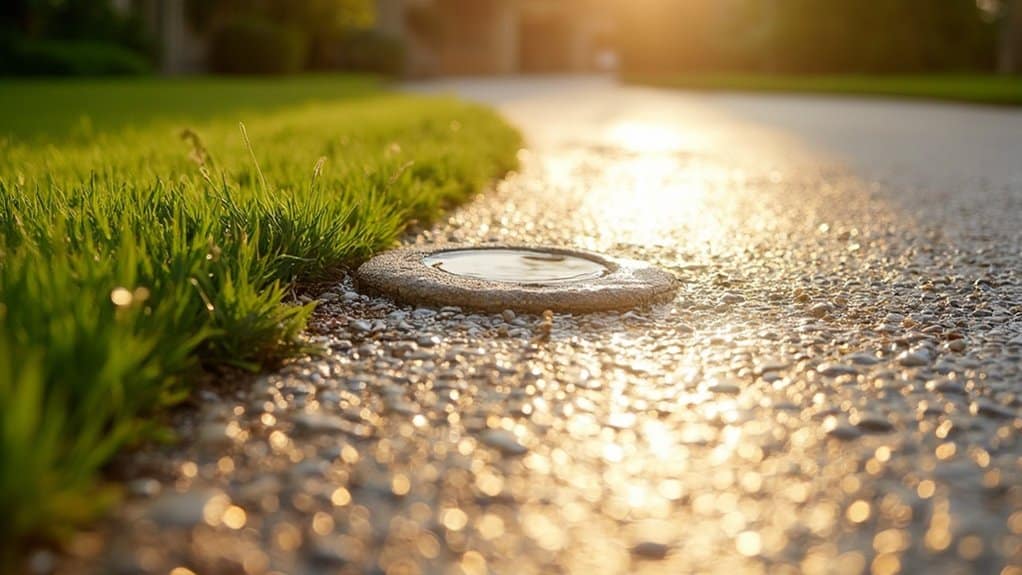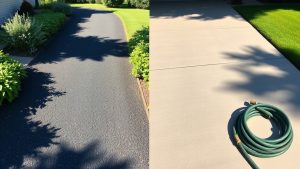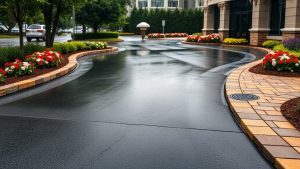Concrete driveways have a notable environmental impact, mainly due to carbon emissions from cement production, which contributes around 8% of global CO2 emissions. The extraction of raw materials disrupts local ecosystems and relies heavily on fossil fuels. Although concrete is durable, its maintenance can also lead to environmental issues. However, innovations such as permeable concrete for better water management and sourcing materials locally can enhance sustainability. There are many sustainable practices and alternatives worth exploring if you’re interested.
Table of Contents
ToggleKey Takeaways
- The production of concrete is responsible for around 8% of global CO2 emissions, which has a considerable effect on the environment and climate change.
- Sourcing materials locally for concrete driveways can bolster local economies and cut down on transportation emissions.
- Permeable concrete driveways enhance water management by allowing stormwater to infiltrate, reducing flood risks and aiding groundwater recharge.
- With a lifespan of 30 to 100 years, concrete driveways outlast asphalt’s 15 to 20 years, leading to fewer repairs and a lower long-term environmental footprint.
- The reflective nature of concrete helps to minimise heat absorption, contributing to urban cooling and lowering energy consumption for outdoor lighting.
Understanding Carbon Emissions in Concrete Production
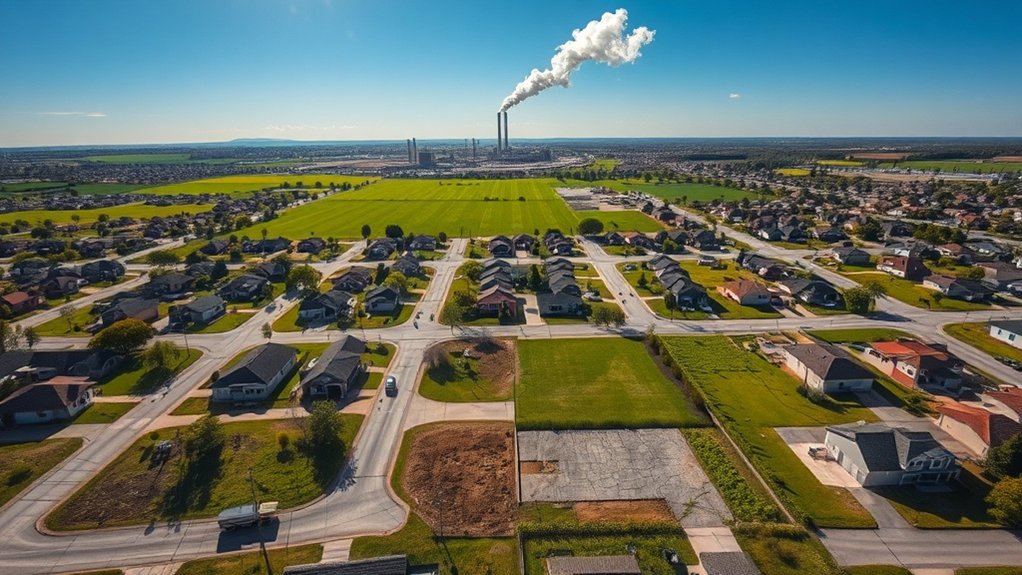
Concrete plays a vital role in modern infrastructure, but its production comes with significant environmental challenges. Cement manufacturing contributes approximately 8% of global CO2 emissions, with about 1.6 billion metric tonnes released in 2022 alone. A large part of these emissions arises from process emissions, where CO2 is emitted during the chemical transformation of raw materials, independent of fuel use. With concrete demand on the rise, emissions could nearly double by 2050. To tackle this issue, innovations in low carbon cements, like LC3, are emerging to lessen the environmental impact. Additionally, carbon capture technology can help reduce process emissions. Furthermore, the cement industry emits over 4 billion tons of carbon each year, highlighting the urgent need for sustainable solutions. Together, these strategies offer promising avenues to decrease the carbon footprint of concrete production and support the development of more sustainable infrastructure.
The Resource Intensity of Concrete
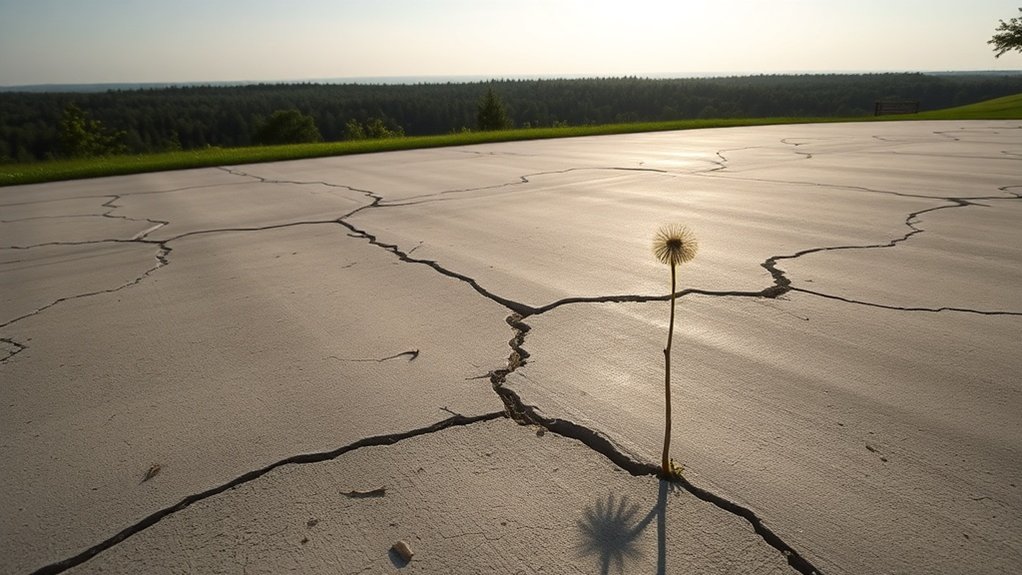
The environmental issues linked to concrete production go beyond just carbon emissions; they also involve its resource intensity.
Cement production requires a large amount of mined raw materials like limestone and clay, which consume considerable energy and water. The extraction of aggregates, mainly sand and gravel], disrupts local ecosystems and depletes resources, especially as urban areas grow. While it’s possible for cement plants to improve energy efficiency, the industry still largely depends on fossil fuels, leading to high energy use. Notably, the emissions intensity of cement production reflects the environmental impact of this process.
To reduce these impacts, we can adopt sustainable sourcing methods, such as using supplementary cementitious materials (SCMs) and recycled aggregates, which improve resource efficiency. However, the availability of these alternatives can vary across different regions, making their widespread use in concrete production more challenging.
Evaluating the Durability of Concrete Driveways
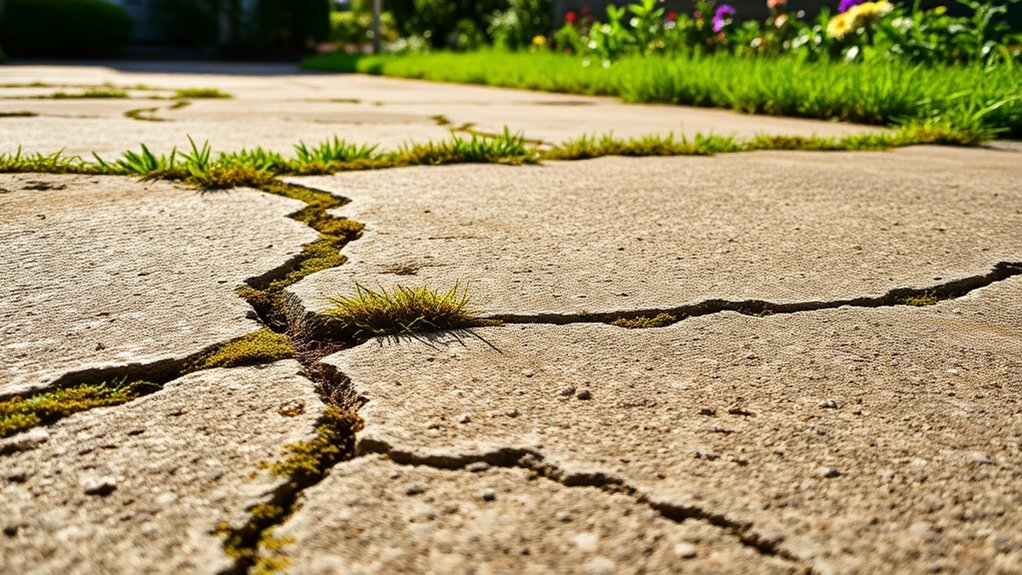
When assessing the durability of concrete driveways, several important factors significantly influence their lifespan. Proper installation techniques, such as adequate base preparation and a well-mixed concrete blend, are vital for enhancing durability. A well-installed concrete driveway can last 25 to 30 years or more, weather conditions, particularly freeze-thaw cycles, can accelerate damage if the concrete isn’t properly sealed. Traffic levels also play a role; standard passenger vehicles typically won’t cause major issues, but heavy vehicles can lead to cracking and deformation. Reinforcement methods, like incorporating rebar, can help reduce these risks. Keep an eye out for early signs of wear, such as small cracks, and address them quickly. Regular maintenance, including cleaning and resealing, can greatly extend the life of your driveway, ensuring it remains functional for many years.
Maintenance Requirements and Environmental Impact
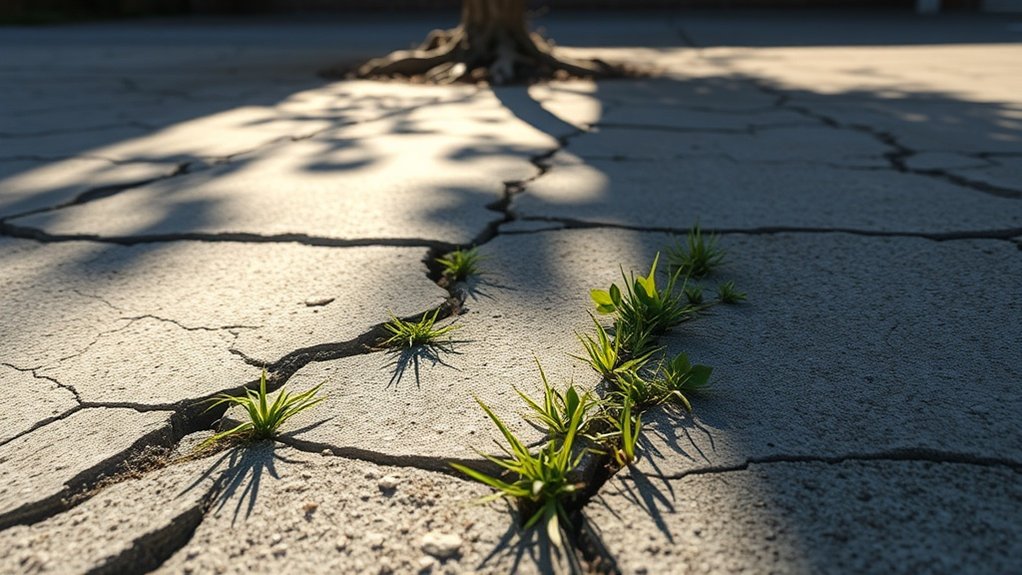
Proper maintenance of concrete driveways not only extends their lifespan but also significantly impacts the environment.
Regular upkeep reduces the need for repairs and promotes sustainability. Here are some key points to consider:
- Clean surfaces regularly to keep them functional and looking good.
- Use sealants to protect against stains and weather damage, which helps prolong their life.
- Address any cracks quickly to prevent water damage and weed growth.
Permeability and Water Management in Concrete
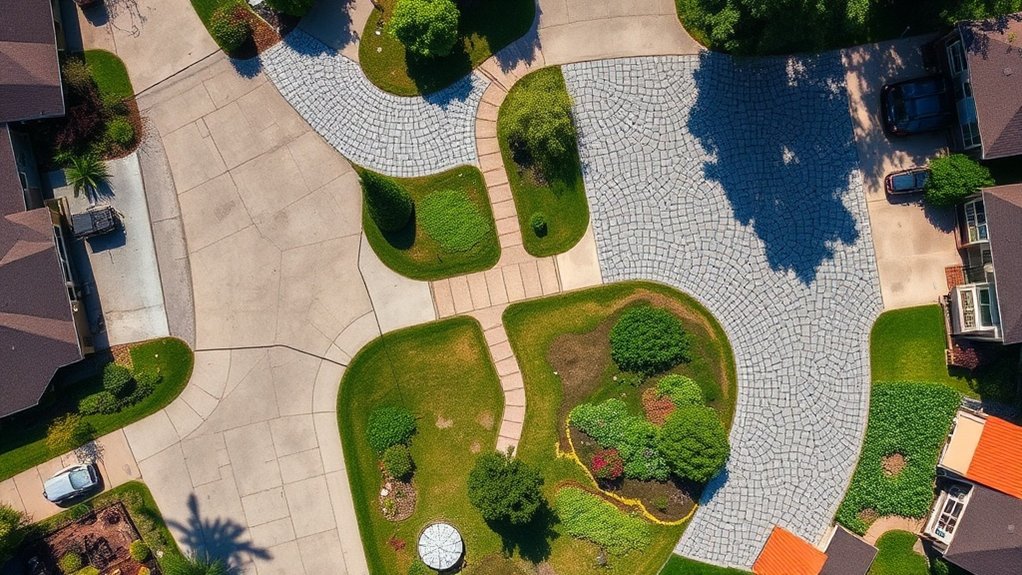
Understanding permeability and water management in concrete driveways is crucial for sustainable landscaping and urban development.
Permeable concrete features interconnected voids that allow water to flow through, improving water filtration and reducing surface runoff. This type of concrete can manage drainage rates of up to 600 litres per minute per square metre, making it effective in heavy rainfall.
By enabling stormwater infiltration, permeable driveways help minimise flood risks and prevent pollutants, such as oils and heavy metals, from entering waterways. They also support groundwater recharge, aiding in aquifer replenishment. Additionally, these driveways can help reduce the urban heat island effect, providing cooler temperatures in densely populated areas.
Regular maintenance, such as vacuum sweeping, keeps these voids clear and ensures their efficiency.
Ultimately, investing in permeable concrete benefits both the environment and urban resilience.
Comparing Concrete and Asphalt Environmental Footprints

When it comes to driveways, concrete and asphalt have different environmental footprints that affect sustainability. Here are key points to consider:
- Carbon emissions: Concrete production contributes about 8% of global CO2 emissions. In contrast, asphalt typically has lower emissions, particularly with the use of warm-mix technology.
- Lifespan and maintenance: Concrete can last anywhere from 30 to 100 years, meaning fewer repairs are needed over time. Asphalt, however, generally lasts only 15 to 20 years and requires more frequent maintenance.
- Recyclability: Both materials can be recycled, but asphalt recycling tends to consume less energy compared to the processes involved with concrete.
- Additionally, tarmac driveways have lower initial costs but may incur higher long-term maintenance expenses, which can influence sustainability considerations.
By understanding these differences, you can better align your choices with sustainability goals and environmental regulations.
Ultimately, the decision between concrete and asphalt involves balancing short-term effects with long-term advantages.
The Role of Recycled Materials in Sustainable Concrete
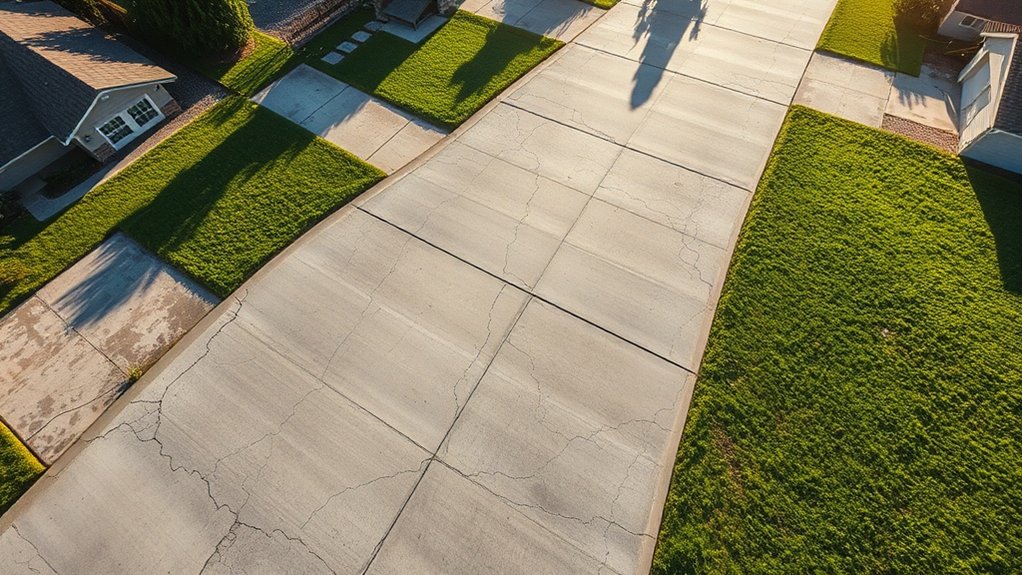
Incorporating recycled materials into concrete mixes significantly boosts sustainability by reducing resource extraction and waste. Recycled concrete aggregates (RCA) can maintain strength and durability, making them suitable for driveways. By using RCA, you not only divert concrete waste from landfills but also reduce costs in sustainable construction.
| Material | Benefits | Applications |
|---|---|---|
| Recycled Concrete | Reduces landfill waste, cost-effective | Base layer for driveways |
| Fly Ash | Lowers carbon footprint | Supplement in concrete mixes |
| Crushed Glass | Replaces aggregate, enhances aesthetics | Decorative concrete applications |
| Woodchips | Reduces cement use | Eco-friendly concrete mixes |
This strategic use of recycled aggregates and supplementary materials is a vital step towards greener construction practices.
Innovations in Concrete Mix Design
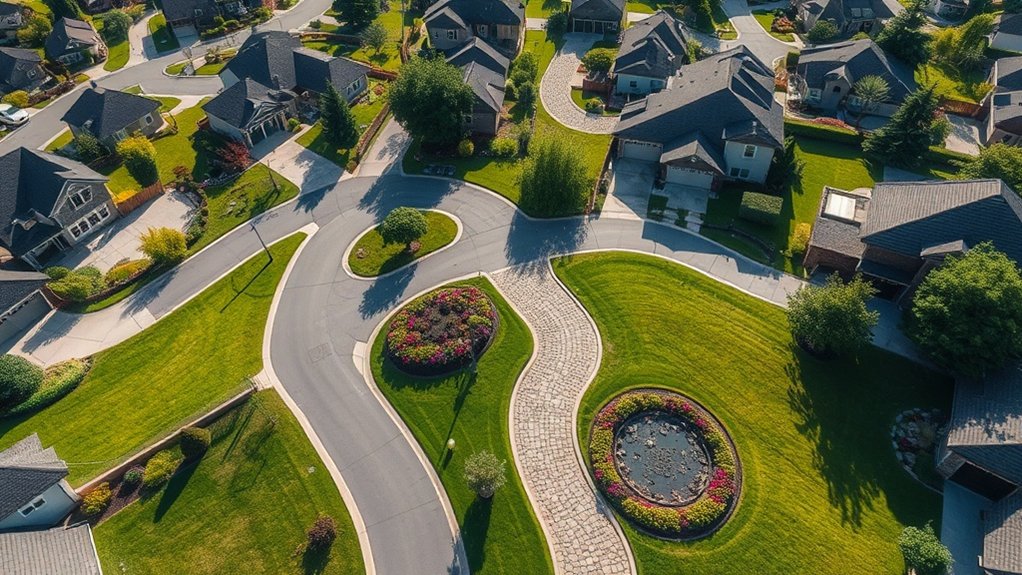
As the demand for environmentally sustainable construction rises, innovations in concrete mix design are becoming essential for reducing the industry’s carbon footprint.
These advancements prioritise sustainable formulations that enhance both performance and environmental impact.
- Advanced Cement Technologies (ACT) can cut carbon emissions by up to 70% while maintaining mechanical strength.
- Self-healing concrete automatically seals micro-cracks, extending its lifespan and reducing maintenance needs.
- AI-driven optimisation identifies alternative materials, boosting sustainability without sacrificing durability.
The Benefits of Local Sourcing for Concrete Projects
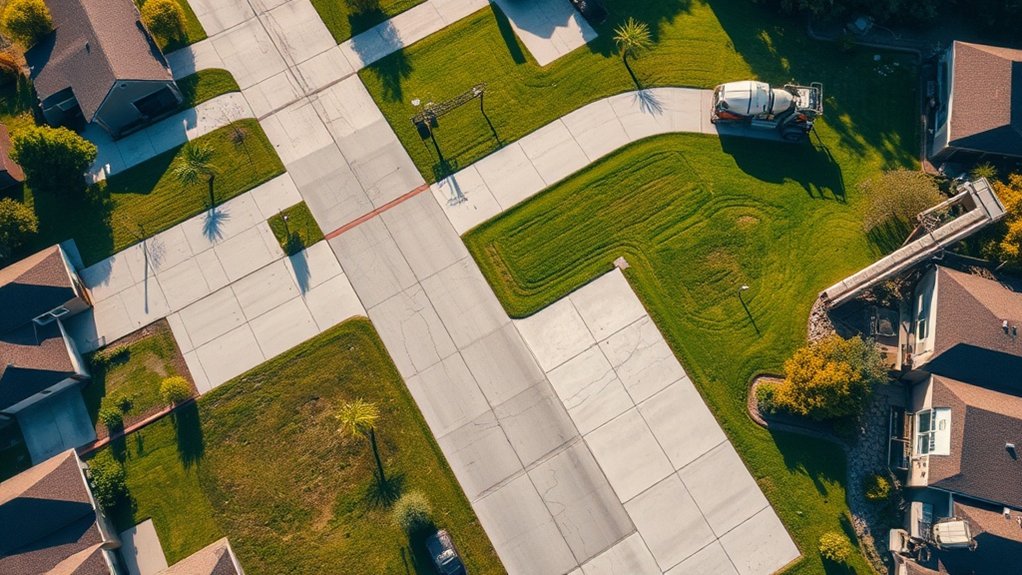
Sourcing concrete locally significantly reduces transportation emissions, which helps lower your project’s carbon footprint.
This not only benefits the environment but also bolsters the local economy by creating jobs and encouraging regional growth.
By opting for local suppliers, you strengthen community ties and promote more sustainable construction practices.
For example, using a nearby concrete supplier can cut delivery times and costs, making your project more efficient.
Reduced Transportation Emissions
Using locally sourced materials for concrete projects significantly cuts down transportation emissions, which is crucial for reducing the environmental impact of concrete driveways.
By streamlining transport logistics, you can achieve substantial emissions reductions through:
- Shorter distances for raw materials, leading to less fuel consumption.
- Decreased reliance on long-haul lorries, which greatly lowers CO2 emissions.
- Improved local air quality due to reduced particulate matter and air pollutants.
These approaches not only lower greenhouse gas emissions but also boost the efficiency of the supply chain.
Support for Local Economy
Sourcing concrete materials locally not only cuts down on transport emissions but also significantly supports the local economy. By investing in local concrete projects, you help create jobs in production, transport, and installation, which strengthens community resilience.
For example, large initiatives like the Vidin-Calafat Bridge have created hundreds of jobs and brought millions in local investment. Local sourcing bolsters supply chains, ensuring stability and reducing dependency on imports.
It also encourages economic diversity by supporting small and medium-sized businesses, enhancing the regional economy. Furthermore, local sourcing promotes better adherence to environmental standards and increases tax revenues, benefiting community services.
Ultimately, you’re contributing to a sustainable economic system that uplifts your community while enhancing your concrete projects.
Mitigating Urban Heat Islands With Concrete
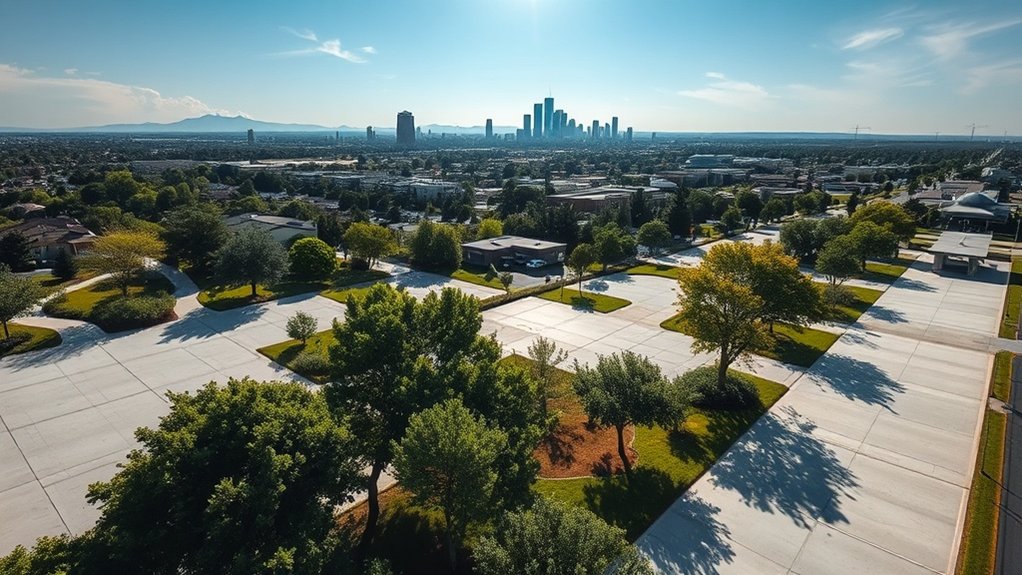
Concrete can either worsen or help mitigate urban heat islands (UHIs).
By using reflective surfaces, heat absorption can be reduced, leading to cooler urban spaces. Furthermore, concrete’s thermal mass helps regulate temperature fluctuations, which can lower nighttime heat release.
For instance, lighter-coloured concrete in car parks can significantly decrease surrounding temperatures during hot days.
Reflective Surface Benefits
While traditional asphalt driveways absorb a lot of solar energy, concrete driveways, thanks to their higher reflectivity, help combat urban heat islands.
The reflective properties of concrete not only keep surface temperatures lower but also improve safety by enhancing visibility.
Here are some key benefits:
- Higher albedo: Concrete reflects about three times more sunlight than asphalt, which means it absorbs less heat.
- Reduced lighting needs: The increased reflectivity can lower outdoor lighting requirements by 20-30%, leading to energy savings.
- Improved safety: Better visibility during darker conditions reduces the risk of accidents for both pedestrians and drivers.
Thermal Mass Regulation
Concrete’s high thermal mass is crucial for temperature regulation in both indoor spaces and urban settings. By absorbing heat during daylight, it helps maintain stable indoor temperatures, which enhances comfort.
However, this heat is released at night, potentially raising nighttime temperatures in urban areas and worsening the urban heat island effect.
While traditional concrete retains heat for longer, using permeable concrete can help alleviate some of these issues by allowing water to seep through and evaporate, cooling the surface.
This highlights the importance of smart design choices, such as opting for lighter-coloured or permeable concrete, to improve thermal regulation in our cities.
Lifecycle Analysis of Concrete Driveways
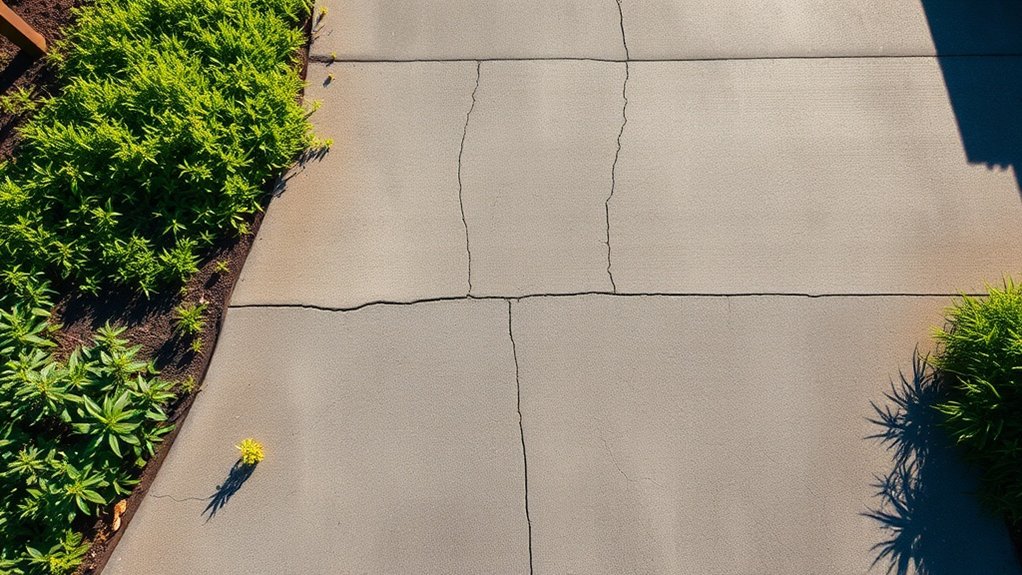
Understanding the lifecycle analysis of concrete driveways highlights important environmental impacts from the extraction of raw materials to the recycling at the end of their life.
Here are the key phases:
- Raw material extraction: The production of cement accounts for around 8% of global CO2 emissions, leading to habitat destruction and depletion of resources.
- Manufacturing energy: The cement manufacturing stage is energy-intensive and releases greenhouse gases. Factors like the curing process and the quality of the concrete mix can influence emissions.
- End-of-life recycling: Crushed concrete can be reused as aggregate, which reduces the demand for new materials and helps lower the overall carbon footprint.
Frequently Asked Questions
How Does Concrete Recycling Work and Its Environmental Benefits?
Concrete recycling involves dismantling demolished buildings, sorting out any contaminants, and crushing the materials into aggregates. This process promotes sustainability by reducing waste sent to landfill, conserving natural resources, and lowering energy use. For example, rather than throwing away old concrete, it can be repurposed for new construction projects, which not only helps the environment but also cuts costs. Overall, efficient concrete recycling is a crucial step towards a more sustainable future.
Are There Any Health Risks Associated With Concrete Driveway Installation?
Yes, there are health risks associated with concrete driveway installation. Dust exposure can lead to respiratory problems and skin irritation. Furthermore, the chemicals in wet concrete can cause burns, so it’s important to use protective gear.
What Are the Aesthetic Options Available for Concrete Driveways?
You can improve the look of your concrete driveway with stamped patterns that imitate natural materials, such as stone or brick. Adding coloured finishes can also bring a splash of vibrancy. These options not only enhance aesthetics but also offer durability, ensuring your driveway complements your home beautifully.
Can Concrete Driveways Be Installed in Cold Climates Effectively?
Yes, concrete driveways can be effectively installed in cold climates. By using frost-resistant materials and proper insulation techniques, you can ensure durability, even during harsh winter conditions. For instance, employing specialised concrete mixes that are designed to withstand lower temperatures can make a significant difference.
What Are the Costs Associated With Concrete Driveway Installation and Maintenance?
The cost of installing a concrete driveway in the UK typically ranges from £30 to £200 per square metre, depending on the materials and any custom features. While maintenance costs are generally low, you may need to budget for occasional sealing and repairs, which can be more expensive than those for asphalt driveways.
Conclusion
If you think concrete driveways are just a simple spot to park your car, think again! They come with significant carbon emissions and resource demands, making them less environmentally friendly than you might expect. While they’re durable and low-maintenance, they also contribute to urban heat islands and can cause stormwater problems. Unless you have a solid plan to innovate and use local materials, it might be worth reconsidering your driveway options. And if you do go with concrete, consider planting some trees to help counteract the impact!
Uncover the hidden environmental costs of tarmac driveways and explore whether they truly align with sustainable living—what alternatives could be Read more
Wondering if a resin driveway is permeable? Discover why it's an eco-friendly choice that benefits both your home and the Read more
Get the scoop on the best eco-friendly driveway sealing options that protect your surface and the environment—discover which one is Read more

